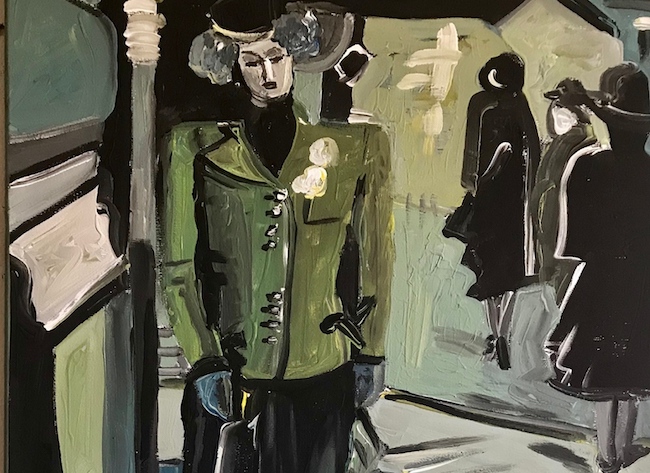Esistono legami con il passato relativamente recente che fanno fatica a essere dimenticati al punto che alcuni artisti sentono la necessità di farne il fulcro della loro produzione pittorica; laddove molti mostrano l’urgenza di narrare il proprio trascorso, le personali esperienze ed emozioni, altri invece avvertono un forte legame con un’intera epoca che genera in loro un sorriso nostalgico, uno sguardo sorridente nei confronti del mondo com’era prima. La protagonista di oggi ambienta le sue opere nel periodo di quei ruggenti Anni Trenta contraddistinti da eleganza e pacatezza, da cui traspare il suo desiderio di fare un salto indietro nel tempo per rivivere quell’epoca.
Nel particolare periodo storico successivo al primo conflitto mondiale e antecedente il secondo, fu contraddistinto da una rinnovata gioia di vivere e dal desiderio di approfittare a piene mani di tutto ciò che era possibile sperimentare, proprio in virtù della consapevolezza di poter perdere ogni cosa, consapevolezza derivata dal contatto con gli orrori della guerra; in quell’epoca l’arte assunse connotazioni differenti in base alle sensazioni rimaste latenti nell’interiorità di ciascun artista. Gli espressionisti posero l’accento sul senso di inquietudine, sulle angosce esistenziali che un periodo tanto instabile e spaventoso come quello del conflitto aveva lasciato nelle coscienze e negli sguardi delle persone. Alcuni tra loro invece ritrassero scene di vita borghese criticandone velatamente la superficialità e la vacuità attraverso cui sembravano aver velocemente dimenticato ciò che poco prima era accaduto. In particolare Emil Nolde e Ernst Ludwig Kirchner seppero infondere alle loro tele il senso di distacco quasi sprezzante dalla nobiltà e dalla borghesia del periodo tra gli Anni Venti e i Trenta del Novecento, narrando individui dall’aspetto deformato, più avvolti da colori irruenti quelli di Nolde e più spigolosi e allungati quelli di Kirchner sebbene in entrambi traspaia la disapprovazione per quel modo di vivere. Al contrario vi furono invece artisti che scelsero di celebrare l’approccio alla bellezza, alla piacevolezza dell’esistenza che contraddistinse il ritorno alla vita dopo la guerra, come Tamara de Lempicka che con la sua Art Decò incantò, e continua a incantare, appassionati di tutto il mondo; in lei sembra essere costantemente presente la ricerca del bello, l’esaltazione di quella rinnovata tranquillità, di quel piacere di poter assaporare ogni istante, tipico di chi ha attraversato il rischio di perdere tutto. Nell’epoca contemporanea Jack Vettriano torna a far percepire al pubblico la nostalgia per quegli anni Trenta, in questo caso quelli statunitensi dei gangster e delle loro donne, attraverso un Realismo che affascina e conquista il pubblico con la sua capacità di trasportare letteralmente l’osservatore in quell’epoca, con le atmosfere sensuali, soffuse, eleganti. L’artista tedesca Sabine Schaefer dedica la sua produzione pittorica a quegli anni, scegliendo l’Espressionismo che però con lei perde l’accezione critica verso un mondo votato all’apparenza e alla forma e ne sottolinea invece la piacevolezza, la naturalezza con cui tutto era vissuto, la classe innata che traspare dai suoi personaggi e che svela l’ammirazione dell’artista e la nostalgia nei confronti di un tempo non vissuto in prima persona ma nel quale avrebbe potuto trovarsi a suo agio. In questo particolare sguardo, e solo dunque nell’intento pittorico, la Schaefer si avvicina all’Art Decò perché la celebrazione degli anni Trenta non porta con sé significati nascosti, non cela una disapprovazione o la contestazione di un modo di vivere e di essere, tutt’altro, nelle sue tele esplora la raffinatezza dei gesti, l’eleganza delle pose, immortala piccoli gesti quotidiani che davanti al suo sguardo diventano attimi da mettere in evidenza attraverso il suo sguardo artistico.
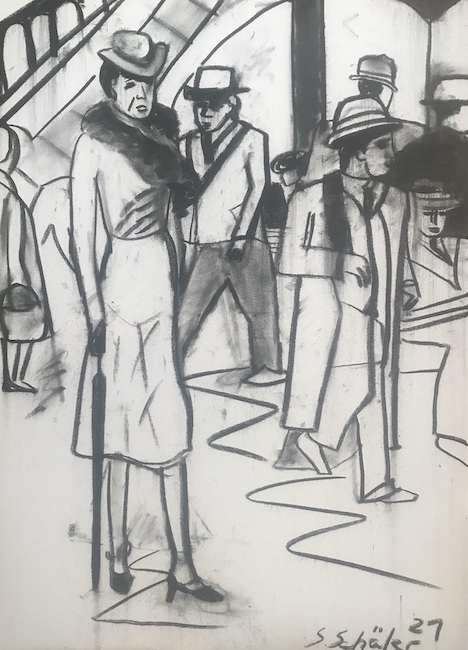
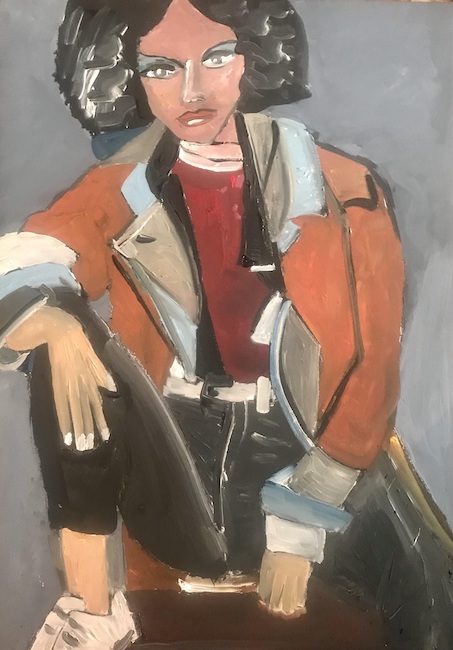
Le tonalità sono a volte più reali altre meno attinenti all’ambiente e alle persone descritte, per lasciar fuoriuscire in maniera più incisiva la sensazione da cui deve essere avvolta la scena, dunque il tratto marcatamente espressionista, derivante da quei contorni netti a definire le figure e gli oggetti, sono enfatizzati dalla capacità della Schaefer di associare la gamma cromatica agli umori e ai pensieri delle persone narrate e protagoniste dell’opera.
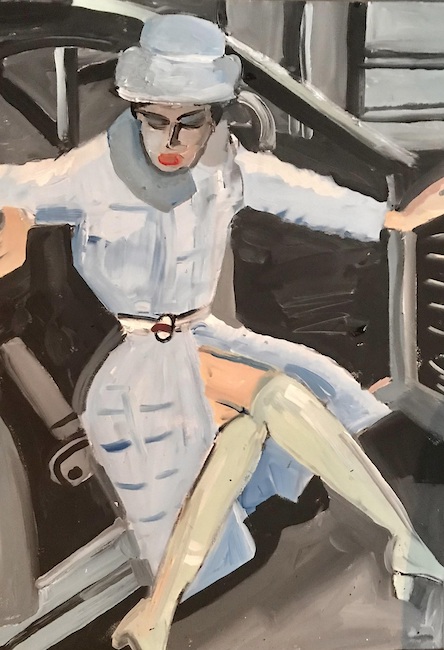
Nella tela Dame la signora raffigurata sembra scendere annoiata da un’auto, come se si apprestasse a presenziare a un evento, a un’occasione, di cui in fondo poco le importa tuttavia mantenere l’apparenza e le buone maniere è insito in lei al punto di diventare irrinunciabile; le tonalità sono realistiche per puntare l’obiettivo sull’intenzione della donna, sulle sensazioni inespresse eppure in grado di trasparire più dal suo atteggiamento che non dallo sguardo o da particolari che nell’Espressionismo divengono secondari rispetto alla capacità descrittiva dell’immagine generale e dall’atmosfera che da essa emana.

Nell’opera Im Cafè, al contrario, Sabine Schaefer racconta di un momento ludico, probabilmente un rituale delle tre persone sedute al tavolo del bar, ognuna avvolta nei propri pensieri eppure con il desiderio di stare insieme, di condividere un frangente di piacevolezza; l’ambiente è caldo, familiare, perciò la gamma cromatica è giocata tutta sui toni del rosa e del nero per rappresentare quelle ore serali in cui le persone sono più rilassate, in cui il contatto diviene più facile perché si è più predisposti all’intimità, all’aprirsi e comunicare. L’avvolgenza del rosa narra di un mondo fatto di buone maniere, di eleganza e raffinatezza, di tranquillità poiché negli anni descritti dalla Schaefer non vi erano i ritmi stressanti e spesso alienanti dell’esistenza contemporanea e dunque l’approccio alla vita era completamente diverso.
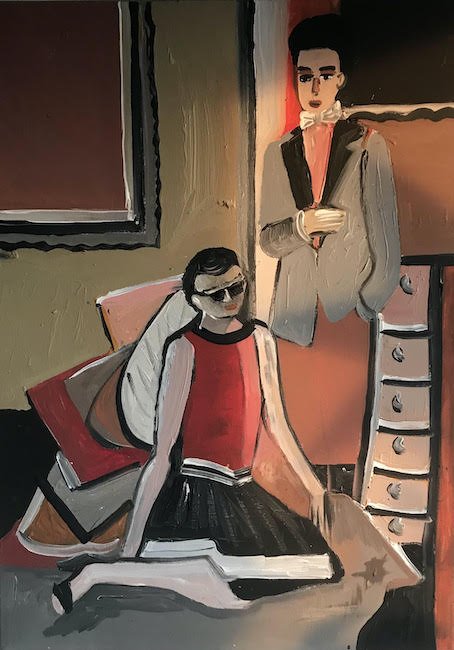
Nella tela Vor der Hochzeitsnacht (Prima della notte di nozze), i due protagonisti sono statici e quasi annoiati, in qualche modo si avvicinano alla gioventù ruggente dei romanzi di Francis Scott Fitzgerald in cui i protagonisti erano costantemente alla ricerca di esperienze nuove e di luoghi in cui sfuggire dall’ordinarietà; non c’è entusiasmo nei personaggi della Schaefer, solo l’attesa di un momento che sta per verificarsi, di un accadimento che, almeno per un breve tempo, costituirà quel nuovo, quella circostanza in grado di vivacizzare l’esistenza ma che subito dopo diverrà parte di una inedita quotidianità, facendo ripiombare la coppia nelle pieghe dell’abitudine. La ricerca estetica è evidenziata dalle linee raffinate e dai colori realistici, come se l’artista volesse mettere in risalto quell’inclinazione all’estetica che contraddistingueva la società del passato tanto quanto quella attuale.
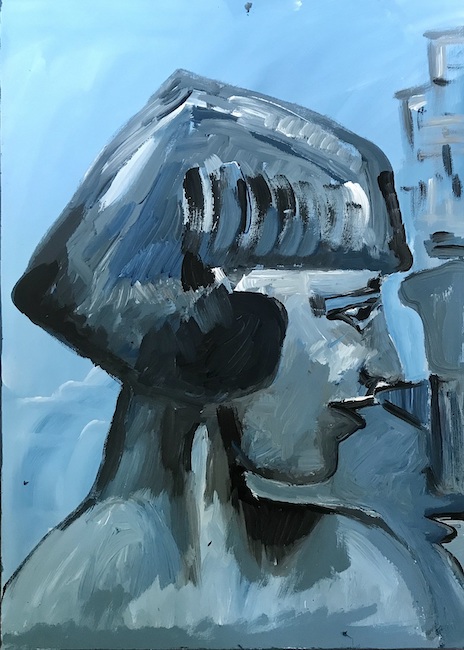
In Portrait einer Unbekannten (Ritratto di una sconosciuta), l’attenzione della Schaefer è catturata dall’espressione del volto della donna, un po’ sorpresa e un po’ compiaciuta dall’incontro con qualcuno che si cela oltre la tela, come se l’inaspettato fosse sopraggiunto riuscendo a modificare l’umore precedente. In quest’opera le tonalità sono completamente orientate al sogno, all’immaginario, quella scala di azzurri che conduce l’osservatore all’interno del frangente della donna costituito forse da un’aspettativa inattesa, dal desiderio di trascorrere un momento piacevole in grado di farla uscire da quella timidezza, da quella ritrosia che si percepisce dalle spalle leggermente chiuse come a proteggersi e dalla bocca solo apparentemente sicura di sé ma in realtà dubbiosa sull’esito dell’incontro.
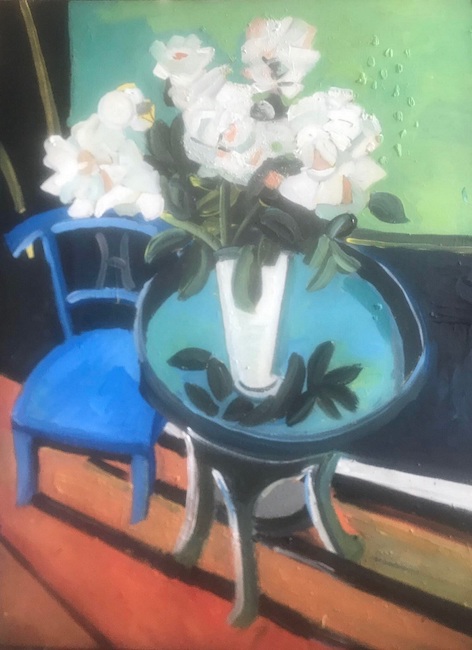
Nelle nature morte, di cui fa parte il dipinto Tisch mit Pfingstrosen (Tavolo con peonie), Sabine Schaefer mostra tutto il suo lato espressionista, quel trasformare un semplice oggetto in qualcosa di vivo in virtù dell’emozione che in lei suscita, forse perché legato a un ricordo o forse per la sua capacità di apprezzare le piccole cose quotidiane; le proporzioni sono alterate per mettere in evidenza il vaso con i fiori, assoluti protagonisti della tela e che dunque devono predominare sul tavolo che li ospita e sulla sedia accanto che fa da comprimaria alla composizione generale. Sabine Schaefer ha partecipato a moltissime mostre collettive in Germania e fa parte del gruppo artistico Kreis34 dal 1994.
SABINE SCHAEFER-CONTATTI
Email: vshafer36@gmail.com
Facebook: https://www.facebook.com/sabine.schaefers.art.profil
Sabine Schaefer’s Expressionism, retro atmospheres of an unforgettable era
There are links to the relatively recent past that are hard to forget, to the extent that some artists feel the need to make them the focus of their painting; while many show an urge to narrate their past, their personal experiences and emotions, others feel a strong connection to an entire era that generates a nostalgic smile, a smiling look at the world as it was before. Today’s protagonist sets her works in the period of the Roaring Thirties, which were characterised by elegance and calmness, and from which her desire to go back in time and relive that era is evident.
In the particular historical period after the First World War and before the Second, there was a renewed joie de vivre and a desire to take full advantage of everything that was possible to experience, precisely because of the awareness of being able to lose everything, an consciousness derived from contact with the horrors of war; at that time art took on different connotations according to the feelings that remained latent in the interiority of each artist. The Expressionists emphasised the sense of unease, the existential anguish that such an unstable and frightening period as the war had left in people’s consciences and eyes. Some of them, on the other hand, portrayed scenes of bourgeois life, veiledly criticising the superficiality and vacuity through which they seemed to have quickly forgotten what had happened shortly before. In particular, Emil Nolde and Ernst Ludwig Kirchner were able to infuse their canvases with a sense of almost contemptuous detachment from the nobility and bourgeoisie of the period between the 1920s and 1930s, portraying individuals with a deformed appearance, Nolde’s being more wrapped up in impetuous colours and Kirchner’s more angular and elongated, even though in both cases their disapproval of that way of life shines through. On the contrary, there were artists who chose to celebrate the approach to beauty, to the pleasantness of existence that characterised the return to life after the war, such as Tamara de Lempicka whose Art Deco enchanted, and continues to enchant, fans all over the world; in her there seems to be a constant search for beauty, the exaltation of that renewed tranquillity, that pleasure of being able to savour every moment, typical of those who have gone through the risk of losing everything.
In contemporary times Jack Vettriano returns to make the public feel nostalgic for those 1930s, in this case the American years of gangsters and their women, through a Realism that fascinates and conquers the public with its ability to literally transport the observer into that era, with its sensual, suffused, elegant atmospheres. The German artist Sabine Schaefer dedicated her painting to those years, choosing Expressionism, which, however, with her, loses its critical connotation of a world devoted to appearance and form and instead emphasises the pleasantness, the naturalness with which everything was lived, the innate class that transpires from her characters and which reveals the artist’s admiration and nostalgia for a time she did not experience first-hand but in which she could have felt at ease. In this particular look, and only in her pictorial intent, Schaefer comes close to Art Deco because the celebration of the 1930s does not carry hidden meanings, does not conceal disapproval or protest against a way of life and being, quite the contrary, in her canvases she explores the refinement of gestures, the elegance of poses, immortalising small everyday gestures that before her eyes become moments to be highlighted through her artistic gaze. The tones are sometimes more real and sometimes less relevant to the environment and the people described, in order to allow the sensation by which the scene is to be enveloped to emerge more incisively. Thus the markedly expressionist trait, deriving from those sharp outlines defining the figures and objects, are emphasised by Schaefer’s ability to associate the range of colours with the moods and thoughts of the people narrated and the protagonists of the artworks. In the painting Dame, the lady appears to be getting out of a car in a bored mood, as if she were preparing to attend an event, an occasion, of which she cares just a little, but maintaining her appearance and good manners is so inherent in her that it becomes indispensable; the colours are realistic in order to focus on the woman’s intentions, on her unexpressed feelings and yet is able to transpire more from her attitude than from her gaze or from details that in Expressionism become secondary to the descriptive capacity of the overall image and the atmosphere that emanates from it.
In Im Café, on the other hand, Sabine Schaefer tells of a playful moment, probably a ritual of the three people sitting at a table in a bar, each wrapped up in his own thoughts yet with the desire to be together, to share a pleasant moment; the atmosphere is warm and familiar, so the colour range is played out entirely in shades of pink and black to represent those evening hours when people are more relaxed, when contact is easier because they are more inclined to intimacy, to open up and communicate. The softness of the pink tells of a world of good manners, elegance and refinement, of tranquillity because in the years described by Schaefer there were none of the stressful and often alienating rhythms of contemporary life and therefore the approach to life was completely different. In the painting Vor der Hochzeitsnacht (Before the Wedding Night), the two protagonists are static and almost bored, in some ways approaching the roaring youth of Francis Scott Fitzgerald’s novels in which the protagonists were constantly looking for new experiences and places to escape from the ordinary; there is no enthusiasm in Schaefer’s characters, only the expectation of a moment that is about to occur, of an event which, at least for a short time, will constitute something new, a circumstance capable of enlivening existence but which will immediately become part of an unprecedented daily routine, causing the couple to fall back into the folds of habit. The aesthetic research is highlighted by the refined lines and realistic colours, as if the artist wanted to emphasise the inclination towards aesthetics that characterised society in the past as much as today.
In Portrait einer Unbekannten (Portrait of a Stranger), Schaefer’s attention is caught by the expression on the woman’s face, a little surprised and a little pleased by the encounter with someone hidden beyond the canvas, as if the unexpected had come along and changed the previous mood. In this painting, the tones are completely oriented towards the dream, towards the imaginary, that scale of blues that leads the observer into the woman’s predicament, perhaps consisting of an unexpected expectation, of the desire to spend a pleasant moment capable of bringing her out of that shyness, that reluctance that is perceived by the shoulders slightly closed as if to protect herself and by the mouth that is only apparently self-confident but in reality doubtful about the outcome of the encounter. In the still lifes, of which the painting Tisch mit Pfingstrosen (Table with Peonies) is a part, Sabine Schaefer shows all her expressionist side, transforming a simple object into something alive by virtue of the emotion it arouses in her, perhaps because it is linked to a memory or perhaps because of her ability to appreciate small everyday things; the proportions are altered to highlight the vase with the flowers, the absolute protagonists of the canvas and which must therefore predominate over the table that houses them and the chair next to it, which plays second fiddle to the overall composition. Sabine Schaefer has taken part in many group exhibitions in Germany and has been a member of the Kreis34 art group since 1994.


